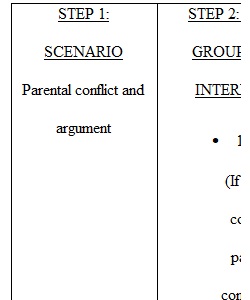


Q PART 1: CREATE YOUR PARENTING CASE STUDY TOPIC Using the planning table provided below, you will create a case study on a parenting topic of interest to you. Throughout the course you will conduct research on this topic, culminating in a Parenting Action Plan that proposes solutions to resolve your case. Step 1: Select a scenario that may be a cause for concern in parents. You may use the list below or identify a scenario of your own with the permission of the instructor. Write your scenario of interest into the planning table provided below. List of Scenarios • Sleeping arrangements for newborn • Immunizations for children • Bedwetting • Breastfeeding older children • Special needs, such as: • Down syndrome or other genetic disorder • Learning disabilities • Autism • Attention deficit with hyperactivity disorder • Physical-motor disability • Language delay, speech, related issues • Teen pregnancy • Alcohol and substance abuse in teens • Relationship problems in teens, dating, inappropriate, and/or risk-taking behavior • Mental health issues (e.g. depression, anxiety, psychotic disorders) • Behavioral issues in younger children • Behavioral issues in teens • Parental conflict and argument • Military deployment • Grandparents raising grandchildren • Adoption/foster parenting • Racial and cultural issues in parenting -Tiger moms, immigrant children, LGBTQ, biracial identity, religion • Older child parenting and emerging adulthood (age 18-21) • Use of media-cellphones, tablets, etc. • Impact of domestic violence • Bullying, cyberbullying • Stepfamilies • Impact of divorce • Choosing daycare, preschool • Healthy diet, eating disorders • College/postsecondary readiness Step 2: Select an age group to which the scenario applies. After picking your scenario, select an age group (see planning table below) that you would be interested in learning more about. For example, if you are interested in “choosing daycare” as a topic, are you interested in daycare for infants, toddlers, or school-aged children? Note that your scenario may not make sense for some age groups. For example, you probably would not be interested in learning about daycare options for an 18-year-old. Step 3: Select a socioeconomic status for your scenario. Determine whether your scenario will apply to a family of lower, middle or upper socioeconomic status (SES) (see planning table below). SES can profoundly impact access to resources which, in turn, can impact outcomes. It is important to know what services are available and who can access them. Step 4: Family composition. Using the planning table below, identify at least two details about the composition of the family. Who is living in the home? How many generations live in the home? What is the marital status of the parents? Are there siblings? Family composition can be a source of strength as well as a source of stress. Use this section to flesh out the details of the family in your scenario. Step 5: Identify the type of issue in your scenario. Use the planning table to identify the type of issue(s) present in your scenario. Check all that you think could apply. This will help you to figure out where you can find information on your topic. For example, if you are dealing with a topic like behavioral issues that emerge in a child after military deployment of a parent, you might start looking for research in psychology journals that deal with military families, like “Military Family Therapy.” Step 6: Identify possible sites of impact for addressing your scenario. Using the planning table, identify possible sites of impact for your scenario. For example, if you are interested in “choosing daycare,” you would probably select “daycare” as a site of impact, but you might also select “home” if you are interested in how daycare impacts behavior in the home. You might also select “school,” if you think the quality of daycare has an impact on academic performance. Step 7: Identify potential solutions to address your scenario. Using the planning table, check off the potential solution(s) that could form the basis of your parenting action plan. Instructions: Choose and write down your topic and ideas about: The topic/title, why you think it is important, and where you think you will look for resources. Use the Planning Table below to create your chosen topic. Each section of the table below may be used to narrow down the specifics of your research paper. Each section will help to get you thinking about the aspects of your action plan. In the example below, the sections of the table appear in parenthesis to exemplify how these sections relate to your topic choice. Please note that these sections form a part of the final paper write up, and as such can be used while writing up your final paper.
View Related Questions